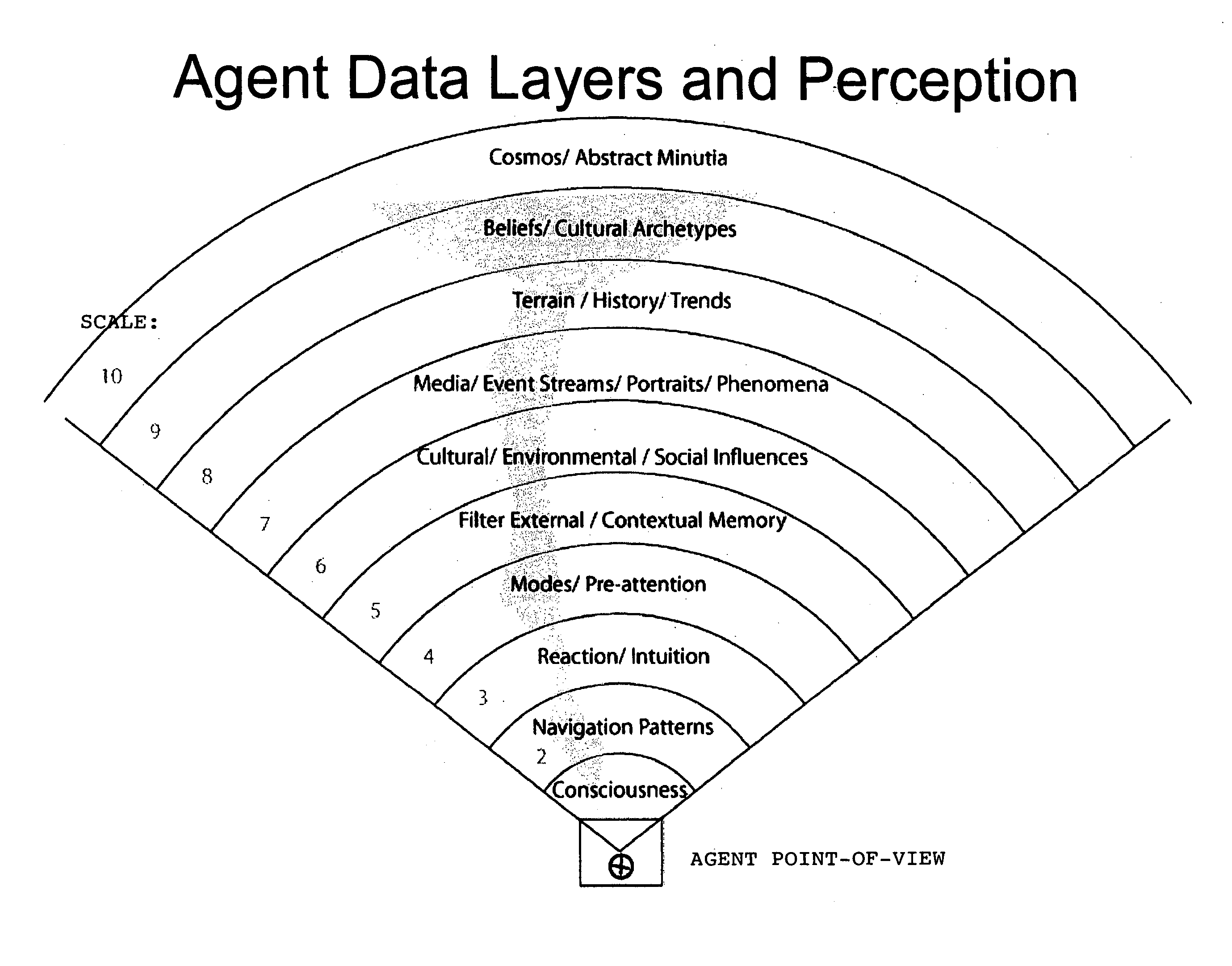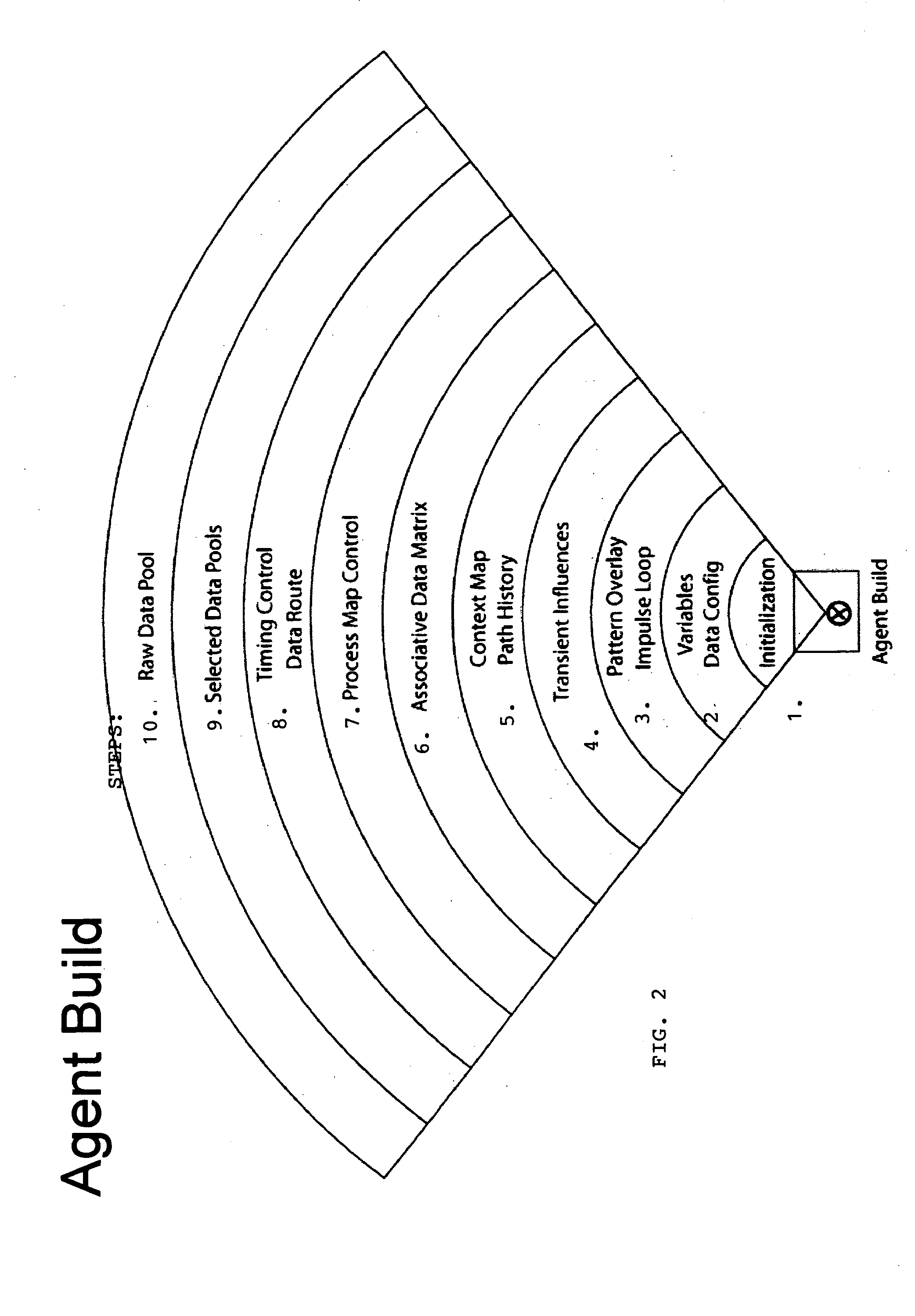[0010] In accordance with the present invention, a
computer simulation method is provided for modeling the behavioral expression of one or more agents in an environment to be simulated, then running a simulation of the modeled agent(s) against real-world information as input data reflecting changing conditions of the environment being simulated, and obtaining an output based on the modeled agent(s) response(s). The simulation method models the underlying cultural, social, behavioral characteristics, qualitative and emotional states, social interaction, desires, beliefs, empathy, individual nature, and / or differences in
perception, reflecting complex decision-making processes on which agent behaviors and actions are based. This is in contrast and sharp distinction to standard industry practice of modeling fixed rules or process for the determining an agent's actions. This method allows the simulation to react to live and / or unanticipated data, or in a manner consistent with its construction but changing in its response as the goals, objectives or environment stimulus change. The input data driving the simulation are constituted by real-world information reflecting the changing conditions of the environment being simulated, rather than an artificial set of predefined initial conditions which do not change over time. As a result, the simulation output of the modeled agent's responses to the input information can indicate more accurately how that type of participant in the simulated environment might respond under real-world conditions. This simulation approach is referred to herein as the "cultural simulation model" or "CSM".
[0011] In one example of a basic implementation of the invention, the agent is modeled as a "point-of-view" (POV) representing any coherent type of human "behavioral expression" or "archetype" of interest. In networked organizations, and as typical of
human behavior, participants tend to form preferential attachments links) to a connector participant (node) with a strong or well-defined point of view or bias. Thus, modeling diverse point-of-view archetypes of agents for a simulated environment provides a more accurate and enduring representation of how multiple different agents (points-of-view) will respond to different real-world conditions thus enabling a human to perceive the world from a point-of-view larger than his or herself. Agents and their behavior as well as archetypical or patterned behavior can be modeled over a wide range of chosen cultural and human personality traits in a manner designed to be highly tolerant and globally inclusive as to
data input, interaction and agent definition type. This
data structure is referred to as "scales" herein. This method allows the inclusion of any
data type enabling interaction with the real world, including text, numerical information, images, sound, environmental conditions, individual and collective personality traits, such as emotional responses of the simulated personality or
group type, real-world events and occurrences through normal channels such as news and
digital sensors, other agents and
system components, and continuing outward to macroscopic influences, such as being part of an overall strategic plan or identifying with one or more cultures, industries, business sectors, organizations that are participating. Each generalized behavioral expression scale can be broken down for fine-grained resolution in terms of "levels" within each scale, and "degrees" within each level. Thus, agent archetypes can be defined, at least theoretically, with unlimited depth and
granularity down to an individual type of person or even to archetypal "facets" of a single personality type. The extension of the method applies to cultural populations and to people in general. An unlimited number of different types of agents (e.g., leaders, followers, helpers, informants, competitors, etc.) can be modeled and stored in this
data format and for comparison and use, selectively for any given simulation.
[0017] The cultural simulation model of the present invention thus provides for "bottom-up" multiagent simulations in which agent point-of-view archetypes may be modeled according to diverse cultural values, beliefs, and / or personal characteristics on which their behaviors and rules for taking action are likely to be based. The cultural simulation model thus simulates how an agent archetype might respond to real-world information given their underlying tenets of values, beliefs, and
modes of
perception including sound, vision, touch, smell and taste, and types of responses in a measurable sense as well as a qualitative sense. Simulations can be run by selecting an agent or multiple agents in a network or internet and information sources representing real-world conditions at a selected time. Simulating the responses of agent types against real-world information allows for more insightful modeling of agents, as well as the extraction of
relevant information about participants in complex or real-world systems and situations. The cultural simulation model can be used for simulations of a wide range of environments, e.g., businesses, competitive markets,
consumer behavior, interactive games, shopping, information navigation, economic policy, political dynamics, social networks, etc. The new
data visualization methods provide robust new visual tools for discerning the responses and interactions of modeled agents in these simulations.
 Login to View More
Login to View More  Login to View More
Login to View More 


